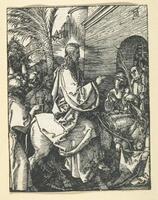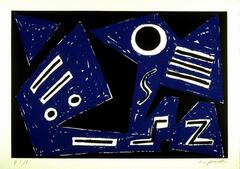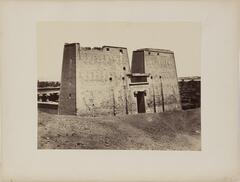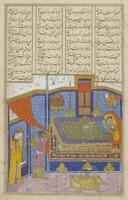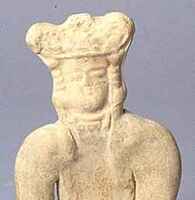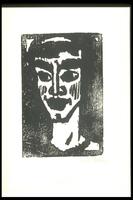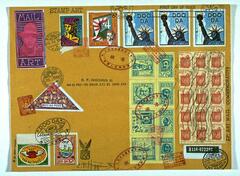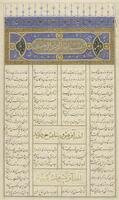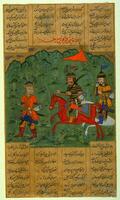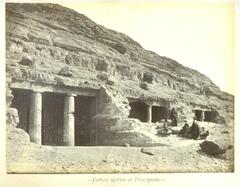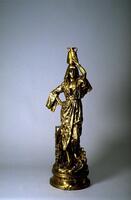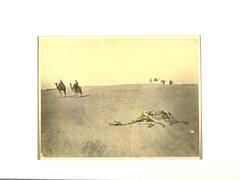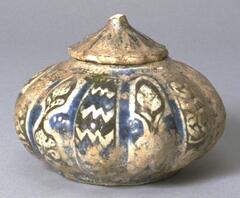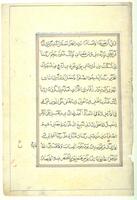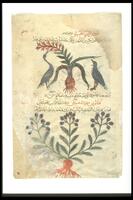22 Items in this Learning Collection
Collection Object
Collection Object
Collection Object
Collection Object
Collection Object
Collection Object
Collection Object
Collection Object
Collection Object
Collection Object
Collection Object
Collection Object
Collection Object
Collection Object
Collection Object
Collection Object
Collection Object
Collection Object
Collection Object
Copyright
All Rights Reserved
()
Ardshir Papakan Sits Upon the Throne in Baghdad, from the Shahnama of Firdausi
Accession Number
1963/1.67
Title
Ardshir Papakan Sits Upon the Throne in Baghdad, from the Shahnama of Firdausi
Artist(s)
Iranian
Artist Nationality
Iranian
Object Creation Date
circa 1460
Medium & Support
ink, opaque watercolor, and gold leaf on paper
Dimensions
10 1/2 in. x 7 in. ( 26.7 cm x 17.8 cm )
Credit Line
Museum Purchase
Label copy
This scene represents the coronation of Shah Ardshir I, the son of a warrior named Papak, and the founder of the Sassanian dynasty, who ruled from 224 to 241 C.E. The Sassanians were the first Persian house to come to power in over five centuries, and they consciously strove to re-create the great empire of their Achaemenid ancestors, warring with Rome in the west and the Kushan Empire in the east.
Now at Baghdad Ardshir assumed his seat
Upon the ivory throne and donned the crown
That maketh glad the heart, with girdle girt,
The scepter of the Shahs in hand. …
When as
He donned the crown of majesty he spake,
Victorious and glad, upon the throne
Thus: “Justice is my treasure in this world,
Which is reviving ‘neath my busy hands,
A treasure this that none can take from me; …
The world is wholly under my protection,
My policy is to approve of justice.”
The whole assembly blessed him and exclaimed:
“Oh! May thy justice make earth prosperous!”
Warner, VI, 258
As a coronation scene, this picture is of the same type as “Luhrasp Addresses the Heroes” (1963/1.58), but for an unknown reason the artist has placed the ceremony in the open rather than in a palace interior. Note how this image also differs from the earlier example in the costumes and headgear as well as the more ornate throne, visual clues to the difference between the “Age of Heroes” and the “Historical Age” in the Shahnama.
This picture differs from Luhrasp’s coronation scene stylistically as well: here there is a greater effort to individualize the figures through nuances of facial expression, and the flowers wind through the landscape in an organic way. Such differences in style are evidence that this manuscript was the collaborative effort of multiple artists who had been trained in different regional painting centers.
———
Maribeth Graybill, Senior Curator of Asian Art
Exhibited in "A Medieval Masterpiece from Baghdad: the Ann Arbor Shahnama"
August 14 through December 19, 2004
Subject matter
Ardshir Papakan Sits Upon The Throne In Baghdad
Now at Baghdad Ardshir assumed his seat
Upon the ivory throne and donned the crown
That maketh glad the heart, with girdle girt,
The sceptre of the Shahs in hand...
Whenas
He donned the crown of majesty he spake,
Victorious and glad, upon the throne
Thus: "Justice is my treasure in this world,
Which is reviving 'neath my busy hands,
A treasure this that none can take from me;
Ill-doing 'tis that bringeth ill on men.
The world is wholly under my protection,
My policy is to approve of justice."
The whole assembly blessed him and exclaimed:--
"Oh! may thy justice make earth prosperous!"
Physical Description
This Persian miniature is attributed to the Shiraz and Timurid schools, ca. 1460. The painting is done in ink, opaque watercolor and gold leaf on paper. The scene, Ardshir Papakan Sits Upon the Throne in Baghdad, is part of the Shahnama of Firdausi, the Persian book of kings.
Primary Object Classification
Painting
Collection Area
Western
Rights
If you are interested in using an image for a publication, please visit http://umma.umich.edu/request-image for more information and to fill out the online Image Rights and Reproductions Request Form. Keywords
Figures
Iranian Islamic painting styles after the Mongols
Iranian Islamic styles after the Mongols
Persian-Farsi (language)
Shahnama
Timurid
Timurid painting styles
gold leaf
gouaches (paintings)
man
miniatures (paintings)
shahs
watercolor painting (technique)
1963/1.67
Title
Ardshir Papakan Sits Upon the Throne in Baghdad, from the Shahnama of Firdausi
Artist(s)
Iranian
Artist Nationality
Iranian
Object Creation Date
circa 1460
Medium & Support
ink, opaque watercolor, and gold leaf on paper
Dimensions
10 1/2 in. x 7 in. ( 26.7 cm x 17.8 cm )
Credit Line
Museum Purchase
Label copy
This scene represents the coronation of Shah Ardshir I, the son of a warrior named Papak, and the founder of the Sassanian dynasty, who ruled from 224 to 241 C.E. The Sassanians were the first Persian house to come to power in over five centuries, and they consciously strove to re-create the great empire of their Achaemenid ancestors, warring with Rome in the west and the Kushan Empire in the east.
Now at Baghdad Ardshir assumed his seat
Upon the ivory throne and donned the crown
That maketh glad the heart, with girdle girt,
The scepter of the Shahs in hand. …
When as
He donned the crown of majesty he spake,
Victorious and glad, upon the throne
Thus: “Justice is my treasure in this world,
Which is reviving ‘neath my busy hands,
A treasure this that none can take from me; …
The world is wholly under my protection,
My policy is to approve of justice.”
The whole assembly blessed him and exclaimed:
“Oh! May thy justice make earth prosperous!”
Warner, VI, 258
As a coronation scene, this picture is of the same type as “Luhrasp Addresses the Heroes” (1963/1.58), but for an unknown reason the artist has placed the ceremony in the open rather than in a palace interior. Note how this image also differs from the earlier example in the costumes and headgear as well as the more ornate throne, visual clues to the difference between the “Age of Heroes” and the “Historical Age” in the Shahnama.
This picture differs from Luhrasp’s coronation scene stylistically as well: here there is a greater effort to individualize the figures through nuances of facial expression, and the flowers wind through the landscape in an organic way. Such differences in style are evidence that this manuscript was the collaborative effort of multiple artists who had been trained in different regional painting centers.
———
Maribeth Graybill, Senior Curator of Asian Art
Exhibited in "A Medieval Masterpiece from Baghdad: the Ann Arbor Shahnama"
August 14 through December 19, 2004
Subject matter
Ardshir Papakan Sits Upon The Throne In Baghdad
Now at Baghdad Ardshir assumed his seat
Upon the ivory throne and donned the crown
That maketh glad the heart, with girdle girt,
The sceptre of the Shahs in hand...
Whenas
He donned the crown of majesty he spake,
Victorious and glad, upon the throne
Thus: "Justice is my treasure in this world,
Which is reviving 'neath my busy hands,
A treasure this that none can take from me;
Ill-doing 'tis that bringeth ill on men.
The world is wholly under my protection,
My policy is to approve of justice."
The whole assembly blessed him and exclaimed:--
"Oh! may thy justice make earth prosperous!"
Physical Description
This Persian miniature is attributed to the Shiraz and Timurid schools, ca. 1460. The painting is done in ink, opaque watercolor and gold leaf on paper. The scene, Ardshir Papakan Sits Upon the Throne in Baghdad, is part of the Shahnama of Firdausi, the Persian book of kings.
Primary Object Classification
Painting
Collection Area
Western
Rights
If you are interested in using an image for a publication, please visit http://umma.umich.edu/request-image for more information and to fill out the online Image Rights and Reproductions Request Form. Keywords
Figures
Iranian Islamic painting styles after the Mongols
Iranian Islamic styles after the Mongols
Persian-Farsi (language)
Shahnama
Timurid
Timurid painting styles
gold leaf
gouaches (paintings)
man
miniatures (paintings)
shahs
watercolor painting (technique)
